XL-7 2WD V6-3.6L (2007)

positioned on the wheel in order to offset the effects of a heavy spot (3). Wheels that have dynamic imbalance have a tendency to move from side to
side and can cause an action called shimmy. Most off vehicle balancers are capable of checking both types of balance simultaneously. As a general
rule, most vehicles are more sensitive to static imbalance than to dynamic imbalance; however, vehicles equipped with low profile, wide tread path,
high performance tires and wheels are susceptible to small amounts of dynamic imbalance. As little as 14-21 g (1/2 - 3/4 oz) imbalance is capable of
inducing a vibration in some vehicle models.
Balancing Procedure
NOTE:
When balancing tire and wheel assemblies, use a known good, recently calibrated, off-vehicle, two-plane dynamic balancer set to the finest balance
mode available.
1. Raise and support the vehicle.
2. Mark the location of the wheels to the wheel studs and mark the specific vehicle position on each tire and wheel - LF, LR, RF, RR.
3. Remove the tire and wheel assemblies one at a time and mount on a spin-type wheel balancer.
4. Carefully follow the wheel balancer manufacturer's instructions for proper mounting techniques to be used on different types of wheels.
Regard aftermarket wheels, especially those incorporating universal lug patterns, as potential sources of runout and mounting concerns.
5. Be sure to use the correct type of wheel balance weights for the type of wheel rim being balanced. Be sure to use the correct type of coated wheel
balance weights on aluminum wheels.
6. Balance all four tire and wheel assemblies as close to zero as possible.
7. Using the matchmarks made prior to removal, install the tire and wheel assemblies to the vehicle.
8. Lower the vehicle.
Wheel Weight Usage
Tire and wheel assemblies can be balanced using either the static or dynamic method.
Clip-on Weights
NOTE:
When balancing factory aluminum wheels with clip-on wheel balance weights, be sure to use special polyester-coated weights. These coated weights
reduce the potential for corrosion and damage to aluminum wheels.
These coated weights reduce the potential for corrosion and damage to aluminum wheels.
^
MC (1) and AW (2) series weights are approved for use on aluminum wheels.
^
P (3) series weights are approved for use on steel wheels only.
